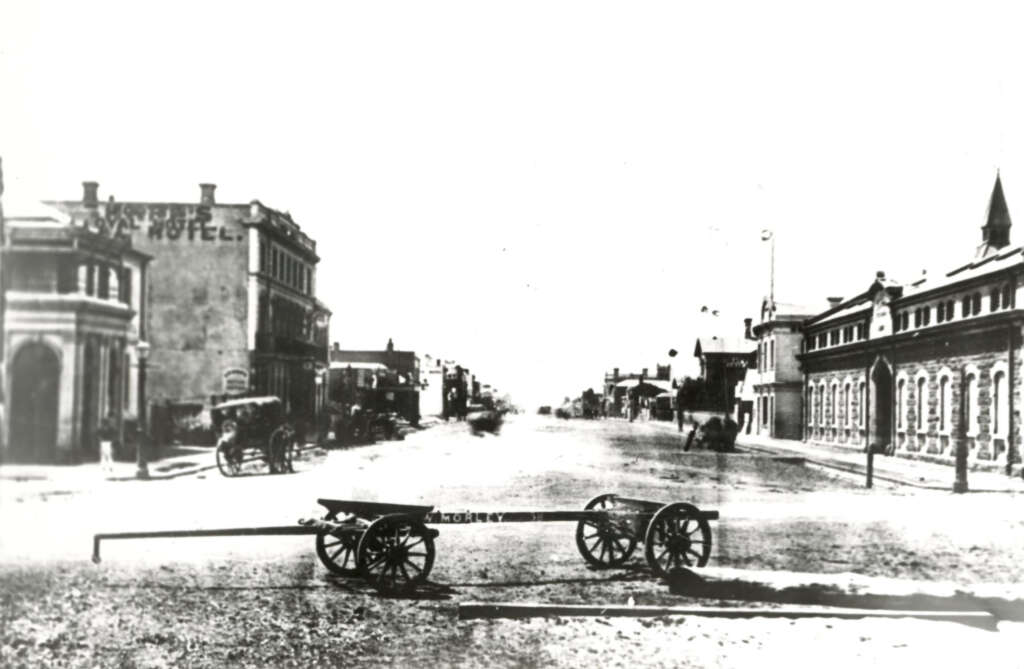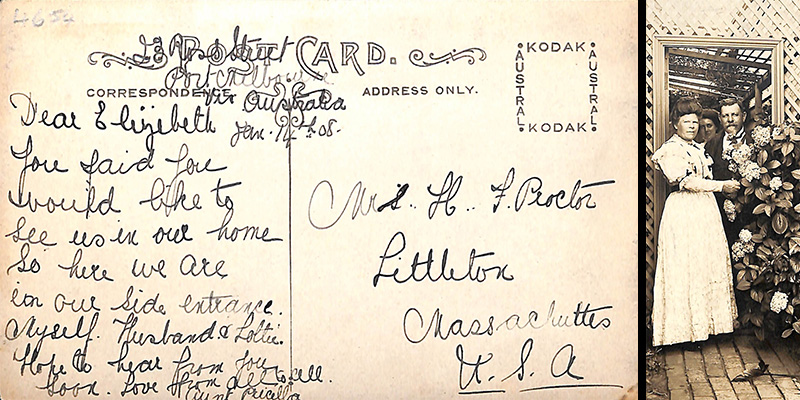A Coal Mine in Sandridge?
by David Thompson
“The Sandridge people are anxious to have a coal mine within their municipality”[1]. So reads the opening stanza of an article titled “Scientific Gossip” from the Leader newspaper on 4 October 1873.
Indeed, The Argus reported that a deputation consisting of Messrs Allison, T Dickson and W H Gresham representing the Victorian Coal Company (Limited) visited the Victorian Minister of Mines, Angus Mackay, on Wednesday, 10 September asking for a licence which would give them exclusive rights to search for coal over an area of several hundred miles. They believed that extensive coal seams existed under the bed of Port Phillip Bay. Mr Mackay said that it was not within his powers to comply with their request, but he could grant them a search-licence over 640 acres which could be taken up “along the shores of the bay”.[2]
[It appears that Allison, Dickson and Gresham represented the Port Phillip Coal Mining Company rather than the Victorian Coal Company as reported in The Argus but corrected in later regional reports.][3]
Having been rejected by the Minister, the company changed tact.
The Sandridge Council, at their meeting on the Thursday evening, read a letter from Mr Dickson, secretary of the Port Phillip Coal Mining Company, asking that the borough surveyor meet with a deputation from the company to “select a site for sinking for coal somewhere on the east side of the lagoon” and asking for support of the Council to secure the land should the venture succeed. Cr Salmon thought that ‘if coal was discovered, the nearer it was found to Sandridge the better for the borough‘.[4]
[Presumably W H Gresham, who had been elected to Council on 12 August[5], excused himself from discussions regarding any assistance for the company.]
On 23 September, Cr Gresham along with Cr Salmon and others visited the Minister for Lands, Mr Casey, to ask for a conditional grant of an acre of land east of the Sandridge lagoon for the purpose of boring and mining for coal. Casey said he could not grant the request unless there were reasonable grounds that coal would be found. Gresham argued that it could not be ascertained whether coal was there or not without boring, however, Casey responded that no professional opinions had been forwarded to him regarding the land. Swallow said the ground in question “was waste and unoccupied” while another member of the group said he had picked up pieces of coal not far from the ground as well as other spots in Hobson’s Bay. Gresham said “small thin seams of coal had already been found in Hobson’s Bay” but Casey stood firm and refused to allow the company to bore for coal without stronger evidence that coal might be found.[6]
An article in Melboune Punch, the next day was unsympathetic to the company’s cause.
“A deputation waited on King Casey on Tuesday last to obtain an acre of land on the eastern by north end of Sandridge lagoon, for the establishment of a Coal Mine. Mr Gresham urged that much (or rather many) might be done by the experiment. All they wanted to do at present was to bore. King Casey said he perceived indications of a boring tendency. … [the deputation] suggested that he was perhaps not aware that several big lumps of coal which had recently been found in the neighbourhood of Morley’s drays were actually in sacks outside the court.”[7]
[Modern-day readers will be aware that the blue stone building at the beach-end of Bay Street still bears the inscription “Morley’s Coal Depot” above the doorway. Punch is clearly suggesting that the coal found in the area had come from one of Morley’s horse-drawn carts rather than a buried seam of coal near the lagoon.]

However, there was some support for the Port Phillip Coal Mining Company’s proposal.
ST wrote to the Ballarat Courier on the subject stating that he had married the daughter of a coal and iron master from Dudley, England and “I have seen some little of the coal formations and, as a mining man, have paid attention to surface indications”. He went on to say that he had found a “piece of good hard coal embedded in the solid stone” when Elizabeth St was newly metalled. He had subsequently visited Sandridge and Williamstown and seen similar stone below the high-water mark. Afterwards he had gone to Geelong by boat and “noticed the newly ploughed land in the distance, on the left hand side of the bay, and saw what I considered carboniferous stains; which led me to believe Hobson’s Bay to be a large coal basin”. ST concluded his letter by saying he had written to the Port Phillip Coal Mining Company on the subject.[8]
On October 2, W H Gresham wrote to The Argus providing further defence of the company’s plans.
“Mr Lee, a diver, of Sandridge, about seven or eight years since was engaged searching the bay, by means of grapnels, for lost anchors and chains. The heavy grapnel used frequently caught in a solid reef, necessitating the descent of a diver to clear it. This reef proved to be coal; several lumps were brought to the surface from it. … Mr Lee is employed at present at the new dry dock at Williamstown, but he can be seen any evening at his residence at Sandridge, where he will be glad to answer any questions on this subject.”[9]
It seems that after less than a month the proposal for a Sandridge Coal Mine came to an end with the final word on the subject coming from the “Scientific Gossip” quoted at the start of our story.
“No one is insane enough to urge that coal exists at Sandridge because it never has been found there, but rather because there is at present no evidence to show that it cannot possibly be there. Carboniferous strata may, certainly, lie underneath the surface sand and the newer tertiaries at many points round the bay, and Sandridge is one, but, at the same time, about the most unlikely of them all. … Possibly the Government would have done well to have acceded to the petition, and even to have supplemented it with a grant-in-aid; Sandridge would then, probably, seeing reason for relinquishing all her expectations of finding coal within her own boundaries, be content to devote her energies to landing that which comes to us from other quarters.”[10]
Perhaps that advice was heeded. Perhaps it would always have been the natural course of development in the area but in little over a decade Sandridge changed its name to Port Melbourne and the piers of the Borough continued to not only bring in coal but also import and export many other goods and resources, welcome visiting dignitaries, see our troops go and come back from war and greet waves of migrants that have done so much to shape multicultural Melbourne.
[1] 1873 ‘SCIENCE – Scientific Gossip’, Leader (Melbourne, Vic. : 1862 – 1918, 1935), 4 October, p. 5. , viewed 11 Sep 2023, http://nla.gov.au/nla.news-article197929973
[2] 1873 ‘DEPUTATIONS.’, The Argus (Melbourne, Vic. : 1848 – 1957), 11 September, p. 6. , viewed 11 Sep 2023, http://nla.gov.au/nla.news-article5871372
[3] 1873 ‘MELBOURNE.’, Bendigo Advertiser (Vic. : 1855 – 1918), 11 September, p. 2. , viewed 11 Sep 2023, http://nla.gov.au/nla.news-article88268086
[4] 1873 ‘MUNICIPAL.’, The Herald (Melbourne, Vic. : 1861 – 1954), 13 September, p. 4. , viewed 11 Sep 2023, http://nla.gov.au/nla.news-article245304616
[5] 1873 ‘MUNICIPAL ELECTIONS.’, The Argus (Melbourne, Vic. : 1848 – 1957), 13 August, p. 7. , viewed 12 Sep 2023, http://nla.gov.au/nla.news-article5869305
[6] 1873 ‘DEPUTATION.’, The Argus (Melbourne, Vic. : 1848 – 1957), 24 September, p. 1. (The Argus Supplement), viewed 12 Sep 2023, http://nla.gov.au/nla.news-article5872206
[7] 1873 ‘A Victorian Newcastle.’, Melbourne Punch (Vic. : 1855 – 1900), 25 September, p. 7. , viewed 11 Sep 2023, http://nla.gov.au/nla.news-article174546414
[8] 1873 ‘COAL IN HOBSON’S BAY.’, The Ballarat Courier (Vic. : 1869 – 1886; 1914 – 1918), 25 September, p. 3. , viewed 11 Sep 2023, http://nla.gov.au/nla.news-article192282414
[9] 1873 ‘COAL UNDER THE BAY.’, The Argus (Melbourne, Vic. : 1848 – 1957), 3 October, p. 1. (The Argus Supplement), viewed 11 Sep 2023, http://nla.gov.au/nla.news-article5872890
[10] 1873 ‘SCIENCE – Scientific Gossip’, Leader (Melbourne, Vic. : 1862 – 1918, 1935), 4 October, p. 5. , viewed 11 Sep 2023, http://nla.gov.au/nla.news-article197929973


2 Comments
Rebecca Lew
Interesting! So is there any 20th or 21st century geological evidence for coal under our feet, hence a missed opportunity? Or did the Port Phillip Coal Mining Company avoid an embarrassing, ill-guided venture?
David Thompson
It is interesting. There was/is coal excavated on the western side of the bay but I don’t know of anything around Port.